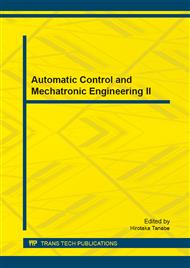p.143
p.149
p.155
p.161
p.166
p.174
p.180
p.184
p.188
Collaborated a Two-Master-Slave Manipulator Arm with Force Reflection for Defined Miniature Tasks
Abstract:
This paper presents the development of a two-master-slave manipulator arm with force reflection for miniature tasks operation. The configuration of the two-master-slave arm is shown and the dynamic model of the slave arm is analyzed. The PID controller with the gravity compensation is selected for controlling desired positions of slave-tool-tips. The movements of the slave arm can be specified with coarse and fine motion. For the coarse motion, the slave arm will be moved approach to a specified workspace area with low precision but high speed. For the fine motion, the slave arm will be controlled with low speed so that the operator feels more confident to move the slave arm, through the master arm, with higher precision within the specified workspace. While operating the manipulator system, the operator can turn on/off the virtual fixture to command force reflection at the master arm for preventing a collision between the slave arm and the obstacles inside the specified working space. The experimental result is shown that the manipulator system is able to be used in miniature tasks operation with 1 millimeter precision.
Info:
Periodical:
Pages:
166-173
Citation:
Online since:
September 2013
Authors:
Price:
Сopyright:
© 2013 Trans Tech Publications Ltd. All Rights Reserved
Share:
Citation:


